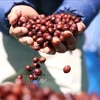Vietnamese cosmetics producers are trying to regain domestic market share by developing new natural products and enhancing their presence in modern distribution systems.
Vietnam's cosmetic market is seen as having a huge potential, with a turnover of roughly 15 trillion VND (704.2 million USD) every year.
Online news website VnExpress also quoted a Nielsen market survey as saying that spending for cosmetic products per capita among Vietnamese consumers remains modest at only 4 USD every year, compared with spending for cosmetic products per capita among Thai consumers at 20 USD per year. Based on this, the market potential for Vietnam remains huge.
According to the Ho Chi Minh City Chemicals and Cosmetics Association, the country currently has more than 400 cosmetic companies, but only 10 of them are well known. Currently, about 90 percent of domestic cosmetics market share belongs to foreign companies.
Nguyen Kim Thoa, Chairwoman of the HCM City Chemicals and Cosmetics Association, said it was difficult for Vietnamese cosmetic products to compete against imported products, as most domestic producers were small and medium in scale and lack capital for investment in technology, product development and trademark promotion.
Most of the cosmetics made in Vietnam are currently distributed at traditional and outdoor markets while cosmetics made abroad are showcased at high-class commercial complexes.
Ly Nguyen Lan Phuong, General Director of Saigon Cosmetics Company, admitted that her company's distribution network was mainly in rural areas and outdoor markets. The company sells roughly 500,000 perfumes every year, but exports to Cambodia, Laos and Thailand account for 40 percent of her company's turnover.
It is the same with the Lan Hao Cosmetic Company, whose key markets are located abroad in spite of its 30-percent growth rate in the domestic market, said Huynh Ky Tran, the company director.
Domestic companies are attempting to regain domestic market share by setting up and developing their distribution systems. Their presence in supermarkets nationwide is gradually increasing.
Phuong of Saigon Cosmetics Company said that besides improving quality and packaging, her company has also increased the presence of its products in big city supermarkets and opened stores to showcase its products.
Meanwhile, Tran of the Lan Hao Cosmetic Company said his company, like other domestic cosmetic producers such as Vinh Tan Technology, TMTM and Hoa Thien Phu Cosmetics, have rapidly capitalised on rising customer preference for products made of ingredients from Mother Nature rather than human laboratories.-VNA
Vietnam's cosmetic market is seen as having a huge potential, with a turnover of roughly 15 trillion VND (704.2 million USD) every year.
Online news website VnExpress also quoted a Nielsen market survey as saying that spending for cosmetic products per capita among Vietnamese consumers remains modest at only 4 USD every year, compared with spending for cosmetic products per capita among Thai consumers at 20 USD per year. Based on this, the market potential for Vietnam remains huge.
According to the Ho Chi Minh City Chemicals and Cosmetics Association, the country currently has more than 400 cosmetic companies, but only 10 of them are well known. Currently, about 90 percent of domestic cosmetics market share belongs to foreign companies.
Nguyen Kim Thoa, Chairwoman of the HCM City Chemicals and Cosmetics Association, said it was difficult for Vietnamese cosmetic products to compete against imported products, as most domestic producers were small and medium in scale and lack capital for investment in technology, product development and trademark promotion.
Most of the cosmetics made in Vietnam are currently distributed at traditional and outdoor markets while cosmetics made abroad are showcased at high-class commercial complexes.
Ly Nguyen Lan Phuong, General Director of Saigon Cosmetics Company, admitted that her company's distribution network was mainly in rural areas and outdoor markets. The company sells roughly 500,000 perfumes every year, but exports to Cambodia, Laos and Thailand account for 40 percent of her company's turnover.
It is the same with the Lan Hao Cosmetic Company, whose key markets are located abroad in spite of its 30-percent growth rate in the domestic market, said Huynh Ky Tran, the company director.
Domestic companies are attempting to regain domestic market share by setting up and developing their distribution systems. Their presence in supermarkets nationwide is gradually increasing.
Phuong of Saigon Cosmetics Company said that besides improving quality and packaging, her company has also increased the presence of its products in big city supermarkets and opened stores to showcase its products.
Meanwhile, Tran of the Lan Hao Cosmetic Company said his company, like other domestic cosmetic producers such as Vinh Tan Technology, TMTM and Hoa Thien Phu Cosmetics, have rapidly capitalised on rising customer preference for products made of ingredients from Mother Nature rather than human laboratories.-VNA



















